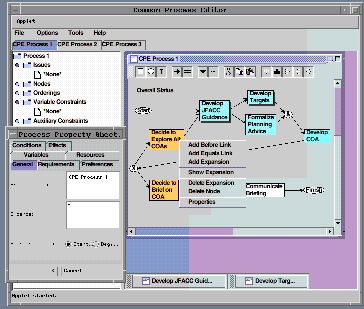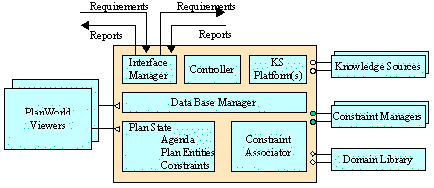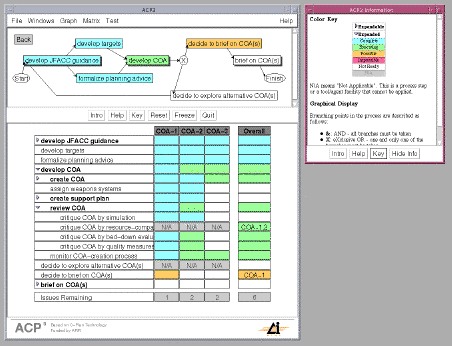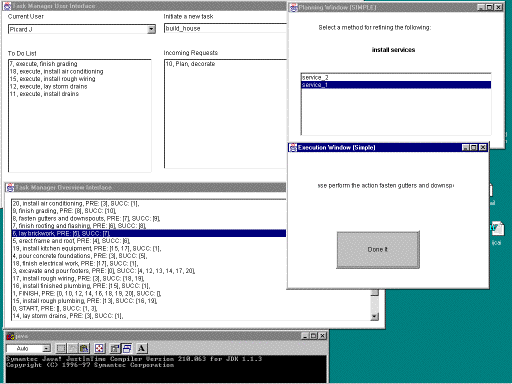I-X: Technology for Intelligent Agents & Tools |
 |
Scope of Work
Work in Intelligent Planning and Activity Management at the University
of Edinburgh has led to a number of significant assets that are
re-used on a number of projects. These assets include: Nonlin,
O-Plan, <I-N-OVA>, Enterprise Ontology, Enterprise Architecture,
Task Manager, O-P3 Panels, Common Process Editor, etc. A
new generation of the work is now proposed which will significantly
extend the application of the core concepts and assets, lead to new
re-usable components, and create opportunities for applications. This
new programme is called I-X and the core components are a
systems integration architecture called I-Core and a shared
model representation called <I-N-C-A>. A variety of re-usable
components and systems will be build on the new architecture and these
will be collectively referred to as I-Technology and
I-Tools.
The "I" in I-X, I-Technology, reflects the following:
- Intelligent - I-X supports the construction of intelligent systems
and intelligent agents
- Integration - I-X is a systems integration architecture
- Issue-based - I-X is an issue-based and issue handling architecture
- (h)Igh level - I-X is a high level abstract architecture
I-X is a new systems integration architecture. Its design is based
on the O-Plan agent architecture. I-X incorporates components and
interface specifications which account for simplifications,
abstractions and clarifications in the O-Plan work over the last 6
years under ARPI. I-X provides an issue-handling workflow style of
architecture, with reasoning and functional capabilities provided as
plug-ins. Also via plug-ins it allows for sophisticated management of
the internal model representations. I-X agents may be recursively
or fractally composed, and may interwork with other processing cells
or architectures. This is a systems integration approach now being
advocated by a number of groups concerned with large scale,
long-lived, evolving and diverse systems integration issues.
The I-Technology programme has 5 aspects:
- Systems Integration - A broad vision of an open architecture for
the creation of intelligent systems based on a workflow process
controller which uses plug-ins to handle "issues" and to manage the
model of the product.
- Representation - a core notion of the representation of a
product as a set of nodes making up the components of the product model, along
with constraints on the relationship between those nodes and a set of
outstanding issues - <I-N-C-A> - Issues, Nodes, Constraints and
Annotations. Engagement with various
standards setting groups is a part of this work.
- Reasoning - the provision of reusable reasoning and model
management capabilities.
- User Interfaces - to understand user roles in performing
activities and to provide generic modules which present the state of
the process they are engaged in, their relationships to others and the
status of the artifacts/products they are working with.
- Applications - work in various application sectors which
will seek to create generic approaches (I-Tools) for the
various types of Task in which users may engage. E.g.,
- I-Model - A Multi-Perspective Modelling Environment which allows
the use of plug-in methodologies and tools.
- I-PE - A specialisation of I-Model to support process and activity
modelling.
- I-Plan - An Intelligent Planning System, which will also be reused
as a workflow process planning aid in the overall approach.
- I-Config - An intelligent Configuration Tool.
- I-Work (aka I-Do) - An adaptor to allow intelligent workflow support
interfacing to distributed commercial workflow support systems.
- I-Help - Emergency Procedure Assistance.
The work has Representation and Reasoning aspects:
- Representation
- Activity Models
- Agent Models
- Product and Artifact Models
- Agent-Agent Relationships - Organisational Models
- Agent-Product/Artifact Relationships - Role Models
- Reasoning
- Modelling
- Configuration
- Planning
- Execution - Task and Workflow Management
Introduction
The DARPA and AFRL Planning Initiative (ARPI) has sponsored work which has led
to significant advances in planning and scheduling technology (Tate, 1996).
Striking advances have been made in the use of AI scheduling and constraint
reasoning methods, which during ARPI have advanced from only being suited to
toy problems to dealing with some of the largest problems that are likely to
be required. The challenge problems and demonstrations domains used during
ARPI have been ideally suited to demonstrating these advances as they are
principally related to large scale asset scheduling (USTRANSCOM) or phasing
(NEOs and ATO generation). These "back room" tasks are characterised by
their relatively regular presentation and large scale - much as industrial
job shop scheduling problems are.
Activity planning technology has also advanced very significantly
during ARPI, and the engineering of such systems is now much better
understood. However, the demonstration of this technology has not
been seen as being so persuasive. Indeed, the types of activity
planning demonstrations being shown within ARPI are at first sight
simpler {Footnote: in fact there is a lot going on
"under the hood" since mixed initiative is now possible, and greater
levels of detail is possible in the activity models used.} than
had already been shown in the mid 1970s and early 1980s by the
pioneers of the first practical planning systems (STRIPS, NOAH,
Nonlin, Deviser, MOLGEN, SIPE). At that time applications included
robot control, engineer's apprentices, electricity turbine overhaul,
Voyager spacecraft mission planning, molecular biology experiment
planning, aircraft carrier operations, etc. Over the last few years
activity planning technology has continued to achieve excellent
results in the industrial (SIPE-2, Wilkins), engineering (OPTIMUM-AIV,
Aarup et. al., Tate), governmental (Search and Rescue, Shadbolt and Tate;
Oil Spill Management, Wilkins), military (KADET, Edwards) and
entertainment (Bridge Baron, Nau) sectors. But little of these
advances and successes has been brought to the fore in the
demonstrations and challenge problems within ARPI. Why?
The nature of the successful applications of AI activity planning are
different to and complementary with those achieved with AI scheduling
and constraint management technology. The whole command, planning,
scheduling, feasibility estimation, execution, monitoring,
modification and control cycle needs a variety of techniques.
Scheduling methods play an important and crucial role in the middle of
this process. BUT, little attention has been paid to the arguably
more important aspects of support to the commander or task and
objectives assigner, the creative selection of the actual activities
to perform (which are then scheduled in the available time, resource
and spatial location), and the subsequent flexible use of the outline
or skeletal plans to GUIDE the choice of activities to actually
select, begin to enact, monitor and modify the activities performed as
circumstances change. Little attention has been paid to the need to
bring the PLANNING PROCESS under control and to improve the
COORDINATION of the human and system agents in that process.
But this presents an opportunity to capitalise on the knowledge gained over
the last few years and to make productive use of technology that to some
extent has laid dormant for the last decade.
Over the last few years the importance of command centre coordination
and workflow or process management has begun to be
recognised. Commercial workflow systems are now available but deal
with relatively simple repeatable processes. Improved cooperation
environments have been provided (e.g. Collaborative Virtual Workspace,
Mitre) but they are simple additional tools not well integrated into
the work management of the user environment. Tieing these together is
something that is recognised as a valuable goal (e.g. in ARPI's TIE
97-5 for the Genoa intelligence gathering process, MCC). TIE 97-1
under ARPI also made productive use of an user level process
visualisation panel (ACP3, Tate et. al.) to communicate to a
commander the status of the development of a range of alternative
options as they were being explored by a wide range of planning and
scheduling tools. The planning process being enacted in command and
control centres is being explicitly modelled and brought under control
in these experiments. There is an increasing realisation that flexible
planning, resource management and coordination of the command,
planning and control process lend themselves well to the use of
advanced activity planning technology.
The interesting observation is that representation of the command, planning
and control process is itself a very suitable type of application for
activity planning technology. It demands knowledge-rich structures that relate
intentions and objectives to activity by a large number of strongly
differentiated agents and who have considerable scope for innovative activity
selection. But the scale is also not too large. In fact, workflow and
planning process planning is often somewhat smaller in scale than problems
already tackled by activity planning systems. The combination of reasonable
size, greater complexity of the domain model and variation in type of
constraints, and of scope for choices between potential activities is a
combination that stands out as being suitable for the application of proven
activity planning technology.
Until recently there have been some technical stumbling blocks which have
inhibited large scale deployment of planning technology.
- The lack of a shared model for activties and plans that could be
communicated externally between users and systems and which would allow for
import and export from specific system representations
- The lack of methods and tools to support the reliable modelling of domains
in a way that could be readily maintained.
Both these areas are ones where considerable advances have been made
in the last few years. Standardisation efforts in the computing
industry (WfMC WPDL), engineering (PIF), business (Enterprise
Ontology), military (CPR, SPAR and WarPlan), and in national standards
(NIST PSL, PIF) has led to a large measure of agreement on the core
entities which need to be exchanged. Formal underlying models for the
shared ontology have been created (e.g., NIST PSL and Toronto TOVE)
and translations to a uniform Sorted First Order Logic have been shown
to provide benefits in communicating this information between planners
and schedulers (Joslin, CIRL, Oregon; Polyak and Tate, Edinburgh).
Languages and translators are now available and have been used on new
start projects rather than people reinventing the wheel, as has
occurred so much in the past. Importantly, these representations
allow interchange of data with existing activity and business process
modelling frameworks - such as IDEF. This addresses the other
stumbling block - where does the domain model and plan/activity
knowledge come from? The principles of knowledge engineering,
software engineering and issue based design are being applied to
ensure that domain models can be created. Initial libraries can be
created from any existing models available by import, and may be used
as skeletal plan fragments or activity templates as is. They can then
be augmented with additional knowledge and constraints as necessary.
New tool support and new methods to support activity modelling is now
a new and growing research topic for US (E.g. AIPS-98) and European
(ESPRIT PLANET network action area) researchers.
So, in short, the time is right to move to a new phase of rediscovering
earlier planning technology and playing to its strengths, improving this in
the light of the ARPI experience, and creating significant new assets that
can be a basis for addressing new challenges and to create new opportunities.
- I-X - We propose to bring together a number of threads of
previous research and development, and use state-of-the-art
understanding of the conceptual basis for flexible, incremental,
mixed-initiative planning systems. We will incorporate these into an
open, flexible, lightweight and embeddible system. This will be
written in Java for portability and to maximise reuse potential. The
core of the system will be an agenda-based issue handling system based
on workflow principles. The framework is intended to be one instance
of the flexible fractally composable component envisaged in recent
DARPA Integrated BattleForce Management architecture discussions. It
will be specialised to any particular task by incorporating suitable
issue-handling capabilities which could be supplied by human or system
components. It will be designed to allow for very significant
extension via an open capability plug-in interface and via an
interface to allow for the use of constraint management methods,
feasibility estimators, simulators, etc. The system will be able to
inter-work with other workflow and cooperative working support
systems, and will not make assumptions about the internal architecture
of those other systems.
- I-Model - An issue based domain modelling system to support
a Multi-Perspective Modelling approach. This provides a
framework for using various methods and existing COTS tool support for
those methods, in the context of creating a single ontologically
underpinned model. A separate shared domain lexicon is built to ease
the construction of relationships betwen the models. Outstanding
modelling issues are used to drive the modelling process and to help
guide modelling efforts.
- I-PE - A Process Editor based on I-Model.
A library of activity templates and skeletal plans
will be stored in, managed by and retrieved from a modelling and
domain management system which will itself employ the agenda-based
system framework. I-PE is a specialisation of I-Model.
- I-Plan - A planner will be built in this architecture and will
use skeletal and hierarchical task network (HTN) expansion and
adaptation planning methods as in O-Plan (Tate). It will incorporate
a range of plug-in depending on the application. These will include
constraint managers for time and resources, spatial and map-based
reasoning, plan feasibility estimation, simulations, plan analysis, etc.
The underlying representation of activities and plans in the system will
be <I-N-OVA> - a specialisation of <I-N-C-A>.
- I-Work (aka I-Do) - The plans created will be used to guide activity
selection in a new "Activity Initiator" system which will itself
interface directly to commercial workflow management technology
(e.g. Fujitsu's TeamFlow or IBM's FlowMark).
- I-View - Viewers for processes, process status, product
development, plans, simulations, etc.
This will incorporate previous Edinburgh work on the PlanWorld Viewers.
- I-P2 - The overall status of the command, planning
and control process as it deals with multiple objectives and possibly
with many options for addressing those objectives will be visualised
through process panels tailored to the specific needs of the different
users and their roles and current foci of attention. This will be
based on recent ARPI work in TIE 97-1 on the Java-based ACP3, and in
the O-Plan COA comparison matrix interface.
I-P2 is a specialisation of I-View Technology.
I-Core
To encourage asset re-use, the Institute has adopted a common systems
integration framework or reference architecture for some of its
projects. It is exploring multi-perspective domain modelling approaches
based on shared underlying ontologies (fundamental characterisations
of the entities and relationships in an application area).
Details of the I-X achitecture are available
here.
The components are as follows:
- Model Manager
-- coordination of the capabilities/assets to represent, store,
retrieve, merge, translate, compare, correct, analyse, synthesise and
modify models.
- Viewers
-- User interface, visualisation and presentation viewers for the model -
sometimes differentiated into technical model views (charts, structure
diagrams, etc.) and world model views (simulations, animations, etc.)
- Controller - Task and Option Management
-- The capability to support user tasks via appropriate use of the
processing and information assets and to assist the user in
managing options being used within the model.
- Issue Handlers
-- Functional components (model analysis, synthesis or modification).
- Constraint Managers
-- Components which assist in the maintenance of the consistency
of the model.
- Information Assets
-- Information storage and retrieval components.
- Mediators
-- Intermediaries or converters between the features of the model and
the interfaces of active components of the framework (such
as viewers, processing assets, constraint managers and information assets).
A number of different types of "sockets" are available within the
framework to reflect the protocols or interfaces into which the
various components can fit. The necessity for specific sockets and
the types of components vary across projects to some extent, but the
separation into viewers, processing assets, constraint managers and
information assets has been found to be useful in a number of AIAI
projects. This also puts AIAI's work on a convergent path with other
Model/Viewer/Controller styles of systems framework.


I-Ontologies & <I-N-C-A> - Shared Models
The approach comprises:
- Shared Models and Standards: Investigating the use of
shared models for task directed communication between human and
computer agents who are jointly exploring a range of alternative
options for activity.
A number of concepts are being used as the basis for exploring task
orientated multi-agent and mixed-initiative work involving users and
systems. Together these provide for a shared model of what
each agent can and is authorised to do and what those agents can act
upon. The concepts are:
- Shared Object/Product Model -- a structured representation of the object being modelled or produced
using a common constraint model of the object or product
(<I-N-C-A>).
- Shared Planning and Activity Model -- a rich plan
representation using a common constraint model of activity
(<I-N-OVA>, itself a specialisation of <I-N-C-A>).
- Shared Task Model -- Mixed initiative model of "mutually
constraining the space of objects/products".
- Shared Space of Options -- explicit option management.
- Shared Model of Agent Processing -- handlers for issues (functional
capabilities) and constraint managers.
- Shared Understanding of Authority -- management of the authority to
do work (to handle issues) and which may take into account options
and levels of abstraction of the model of the object or product.
In particular, this work will carry forward the development of a
strong systematic ontology to underpin the models of processes and
activity - including continuing to engage in and promote its use as a
basis for standards. The work will draw on the initial efforts to
create an ontology suitable for the conceptual description of all
apsects of an organisation - the Enterprise
Ontology and on the development of a constraint model of
activity <I-N-OVA>. The
work will promote the aim that PIF, NIST PSL, OMWG CPR and SPAR all
converge on a single core model of activity based on <I-N-C-A>.
- Intelligent Inter-agent Task Management:
Using these shared views of the roles and function of various users
and systems involved in a work environment,
we have already demonstrated a planning agent being used to support mixed
initiative task specification and plan refinement over the world wide
web.
- Method-based and Issue-based Process Editor: A
process editor will be created (as a Java-based web accessible
facility) to support the initial creation, and subsequent maintenance
of the shared models of the domain which are required. We wish to
re-new work (which has languished since the mid 1980s) on the capture
of design and decision rationale in plans and process descriptions.
This is complimentary to the dependencies and causal rationale that is
maintained in most AI planners today. This information will be
valuable in automated planning as well as in human cooperation.
Issue-based reasoning will be used to capture the state of modelling
especially when multiple domain experts and modellers are involved and
there are inconsistencies in the information available. We call this
approach Multi-Perspective Modelling.
I-Model - Multi-Perspective Modelling Approach
AIAI has been using multiple perspective, multiple methods modelling
methods for some time. It has done practical modelling work (e.g. on
the ARPI ISAT Project Air
Campaign Planning Process) using such methods. We have also used
Multi-Perspective Approaches to reasoning about plans in the O-Plan
work under ARPI. AIAI has used the terms Multi-Perspective Planning
in the title of the most recent O-Plan project, and as a work package
and technique name under the DARPA HPKB project.
Typical multiple perspective models have created a single
ontologically underpinned model using our work on ontologies for
processes and for enterprises and utilising several modelling methods
from Europe (such as CommonKADS - itself combining a number of
perspectives), the UK (such as Role/Activity Diagrams), and the USA
(e.g., IDEF-3). Multiple-view or multiple perspective modelling is
viewed in the software engineering and requirements capture
communities as a valuable technique.
AIAI has been moving towards an approach to support modelling
where we use a range of methods, and create a single shared model
based on one or more small generic ontologies or conceptual
models. The terminology in the model is anchored in a lexicon, which
itself can be developed during modelling. Modelling support is
provided by the creation of an agenda of outstanding modelling
issues. These will eventually be able to be handled by seeking
issue handlers which will select appropriate methods or tools
to help the modeller address the outstanding issues.

Sample methods we have experience of are:
- CommonKADS for organisation, task and other models
- IDEF-3 for process models
- RADS for role/activity models
Sample ontologies we are using as targets for the models are:
- Enterprise Ontology
- <I-N-OVA> Constraint Model of Activity
- OMWG CPR
- PIF 1.2
- NIST PSL
It should be noted that most of these are activity or process
ontologies which reflects a main technical direction for AIAI in
process and task management, or activity related task support.
Lexicons that are being used to anchor models have come from:
I-PE

The screen image shows Steve Polyak's <I-N-OVA> centred issue-based
process editing environment - the Common Process Editor. This will
be one of the sources of inputs for I-PE.
More details are here.
I-Plan

To be completed.
I-Config
To be completed.
I-P2

More details are here.
I-View
PlanWorld Viewers and Process Product Viewers. To be completed.
I-Work (aka I-Do)

The screen image here is from the agenda-based Task Manager from AIAI's Task
Based Process Management project funded by EPSRC.
To be completed.
I-Spy: Areas of Study
- Presentation (of information)
- Visible indications of users' workflow state
- Multiple views tailored to user role, information type, etc.
- Selection of what information to display.
- Views (e.g. tables) that facilitate comparison.
- Summary form with drill-down /expansion to details.
- PlanWorld Viewers
- Colour-coding of status
- Colour choice principles
- Layout principles
- Multi-user cooperation
- User roles (as distinct from physical users)
- Mixed-initiative
- Authority
- Workflow
- Issues (explicit representation and tracking of)
- Delivery (of applications, e.g. on Web)
- Portable
- Standards (XML/RDF markup)
- Familiar interfaces (e.g. Browsers)
- Low bandwidth use (e.g. cellular phones, WAP)
- Reusable frameworks and modules
- Workflow
- Workflow of using the system itself
(hence meta-workflow in workflow tools)
- Issues (again)
- Openness
- An architecture / framework.
- Plug-in concept and implementation support.
- Plug-in Knowledge sources, Constraint managers, Plan evaluators,
TechWorld viewers
- Scenarios
- Emergency or Unfamiliar Procedure Assistant -
Context sensitive Cell Phone or web access to procedural assistance
- Multi-national Coalition Scenario - DARPA CoABS program in cooperation
with DERA, AFRL, Boeing, MIT, Stanford University, and USC/ISI
 Page maintained by a.tate@ed.ac.uk,
Last updated: Thu May 29 15:48:42 2003
Page maintained by a.tate@ed.ac.uk,
Last updated: Thu May 29 15:48:42 2003








